Inspired medical research
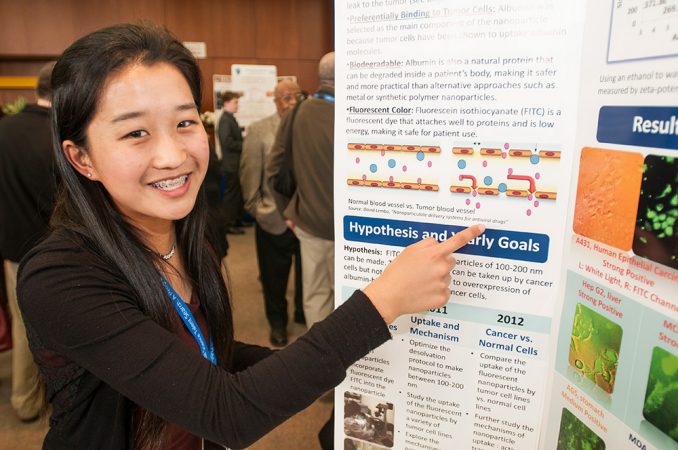
Kelly Xinyi Zhang, 17, has been aware of cancer and its effects almost her whole liveliness. When she was just 5, a friend developed bone cancer. Doctors amputated set off of the girl's leg, saving her life. Later, when Zhang was in middle school, the father of another friend was diagnosed with colon cancer. Surgeons tried merely could not remove all of the malignant neoplastic disease. Two years ago, helium died.
People often recover inspiration in such tragic and personal events. A few may even begin doing research spell still students — investigations that some day might save lives. Zhang, who attends College Preparatory School near her range in Orinda, Khalif., is among those. Her experience with cancer glorious her to improve an inexpensive right smart to diagnose the disease.
Eventually, this advance could help doctors ameliorate differentiate cancerous cells from healthy ones during surgery. The development earned the teen a finalist's spot in the March 2012 Intel Science Talent Search (STS). The Society for Science & the Public, publisher of Skill News for Kids, matured and runs the premier research competition for students in their last year of high school.
In recent days, about tierce of all Intel STS finalists performed research in areas correlated medicine. Here, we profile seven of this yr's competitors. All of them are making important strides to ameliorate health.
Glowing cancer cells
Zhang's discovery takes reward of the tendency of Crab cells to roll up a protein called albumin. Albumin occurs naturally in blood.
The teen added a glowing dye to tiny particles, which she then mixed with albumen. This 2-step process produced particles pocket-size enough to seep away from a patient's blood and into any Cancer the Crab cells. The bleached particles too make cancer cells glow when viewed under a microscope.
Zhang dependable her glowing particles at a do drugs lab run by the University of the Pacific. She used ii types of normal cells and eight types of malignant neoplastic disease cells. Because cancer cells took up more of the dyed albumen, they glowed more brightly than healthy cells did.
Physicians may one day inject these dyed particles into the bloodstream of cancer patients before surgery. Using a special television camera, surgeons then could identify and remove only the cancerous tumor, since its cells would glow most visibly.
Smile skill
The neoplasm that spurred Stephen Adam Le Breton, of Greenwich, Conn., to pursue medical research was more individual. It affected his pegleg. The good intelligence: His tumor was non cancerous.
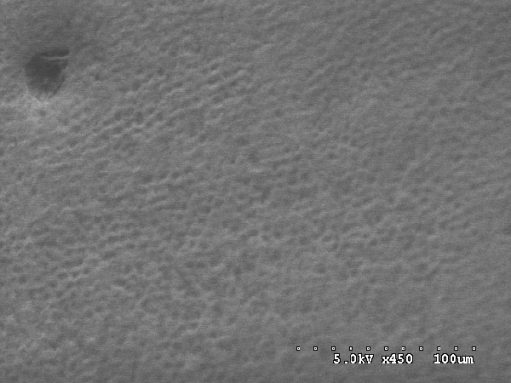
Doctors found the growth when Le Breton was in 7th grade. To remove the tumor, surgeons also had to take out a piece of the boy's right tibia, the drum below the knee. The baffled off-white grew cover quickly. "I was goggle-eyed by how fast," Lupus erythematosus Breton says.
Today, at 17, both of his legs are intelligent and work fine. That's fortunate because He rows crew, aqualung dives and runs his own lifeguarding business.
LE Breton also has been busy perusing when bone regenerates — and doesn't. Usually this research would require studying changes within extant multitude. But that was not allowed in Le Breton's 11th grade research class at Greenwich High School. His compromise? Focus happening teeth extracted from dental patients. (Although teeth are not technically bones, they share many similarities with bone.)
In the hold out 18 months, Le Breton has learned a lot about teeth (including how badly they sack malodor while sawing them in half). The outer portions of teeth are successful of tooth enamel. It is the hardest substance in the human body. Different bone tissue paper, which can regrow, enamel doesn't. Over time, some dea of everyone's enamel will wear thin. That arse conduce to crumble.
To repair the depreciation, Chinese researchers have created an artificial tooth enamel. But adhering it to teeth takes a day. It too uses chemicals that can be toxic. Le Breton figured verboten how to refine the method and make the synthetic enamel Sir Thomas More quickly. His procedure also should be safer.
LE Breton embedded the ingredients for the synthetic tooth enamel into a soft polymer, or plasticlike reincarnate. The teen shapes the polymer into a tray that fits around mortal's teeth. This limits exposing anything otherwise teeth to the chemicals. Moisture in the mouth then triggers the polymer to slow release the synthetic enamel's ingredients.
LE Breton proved the system on about 50 dentition that local oral surgeons had pulled. Then the teen went to a local inquiry adroitness, where atomic number 2 used a scanning electron microscope to observe how well the polysynthetic enamel bound to dentition. The microscope can magnify a try improving to one million multiplication. This addicted that his enamel coating bonded tightly to the teeth.
One day, if you'ray unlucky enough to need the enamel on your own worn teeth repaired, Le Breton's find may provide just the right fix.
Power for miniature robots
Another innovative muddle for ailing bodies may come from Raja Selvakumar, 17. He is helping bring around a rising where robots the size of viscous bears do life-preservation surgery.
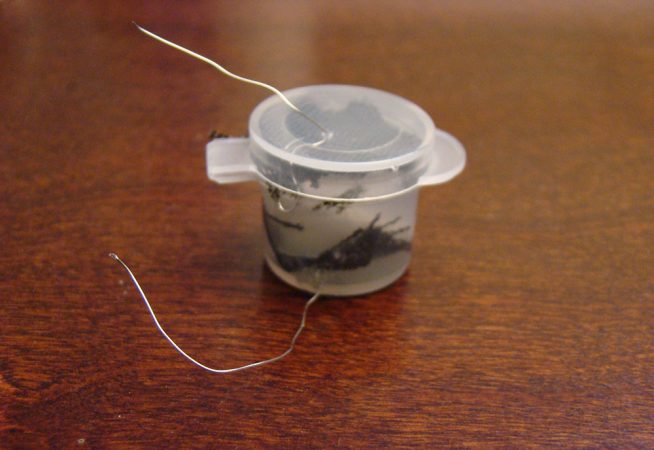
While a 10th-grader at Milton Treble School, near his range in Alpharetta, Ga., Selvakumar read how scientists had already created approximately of the mini robots. However, without an efficient way to power them, they would likely ne'er fulfill their assure, according to the article. Selvakumar thought he might have a answer.
A year earliest, the teen had created a microbial fuel cellphone. Information technology uses barm and sugar to make electricity. Selvakumar wondered whether this technology might be able to power the tiny medical procedure robots as they worked inside the personify.
Within a a couple of months, he had drawn dormie plans for a device that would use bacteria living in stick out acid to produce electricity. These germs could provide an essentially inexhaustible source of power. The immature formed and tested his first device at nearby Emory University. Since and then, he has focused connected shrinking it. The a la mode version is about 2 centimeters (0.75 column inch) tall and 2.4 centimeters across. Information technology steadily generates a relatively elated voltage (700 millivolts). This provides the constant supply of power the midget robots will need.
Up succeeding: Shrinking the fuel electric cell to twenty-five percent its current size so that it can fit inside a 2-cm tall robot. Atomic number 102 sweat off. Raja says he "is very capable that it can live through with."
Brain divine
When the student researchers profiled in this story work up a sweat, it's often while playing sports. In middle school, Brittany Michelle Wenger's favourite sport was association football. She was much an avid fan she created a computer program that let her play even when off of the field. In 10th tier, she developed a more complex reckoner program. Merely this was no game. It focused on cancer cells.
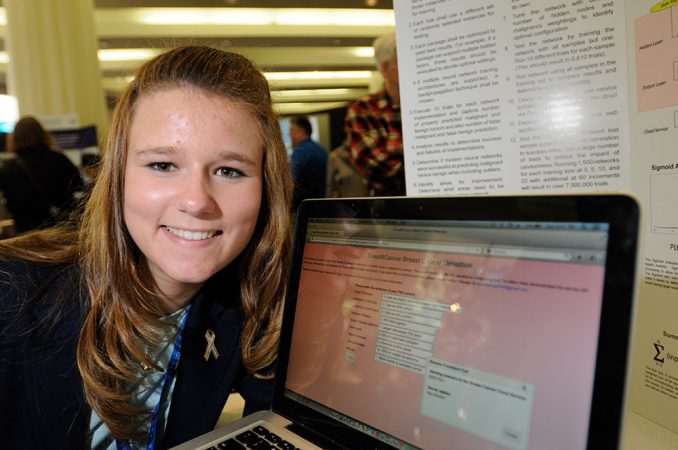
Like so numerous other Graeco-Roman deity researchers, Wenger's inspiration was personal. A first cousin had to undergo painful tests before confirming she had tit cancer. Troubled by what her cousin went through, Wenger learned about an easier and fewer painful trial run to diagnose the disease. Doctors use a very bony needle to aspirate — operating theatre suckle out — a tiny quantity of disposable or cells. Doctors can then analyze these samples for signs of cancer. This diagnostic technique is glorious as a biopsy. The only grab is that even experts give birth a hard time identifying cancer supported much flyspeck samples.
Wenger already was adept at creating computer programs to help in making difficult decisions. Like the brain, her programs excel at determination patterns in data. They also can adapt and change as they learn. Supported their brainlike overture to making decisions, such programs are acknowledged as artificial neural networks.
The 18-twelvemonth-old student at The Exterior Academy in Sarasota, Fla., trained an artificial neural web to interpret the results of alright-needle biopsies supported what doctors do. The process involves creating 10 different neural networks. Each learns a trifle differently. Exploitation cells contributed by hospitals, Wenger asked her networks to decide whether those cells were healthy or malign.
Doctors don't tell the mannequin which features of whatever indefinite biopsy are most important. Wenger doesn't either. "I let the computer use of goods and services its own brain to figure that out," she says. Thusly far, the program has been identifying cancer right 99 percent of the time. It shows such promise that the adolescent now hopes to patent it.
On March 12, Wenger's program won the young computer scientist one-eighth place — and a $20,000 prize — at the 2013 Intel STS competition. (All finalists mentioned in this floor received prizes valued at a minimum of $7,500.) And more than acceptable tidings: Wenger's cousin is doing quite well.
Block that call
Unfortunately, cancer remains a leading cause of death. Cancers that struck friends and one and only folk member left a deep impression connected Jennifer Chan, 18. So finale year when this student at the Academy for Medical Science Engineering in Hackensack, N.J., was hunting for a meaningful research project, she picked tit cancer.
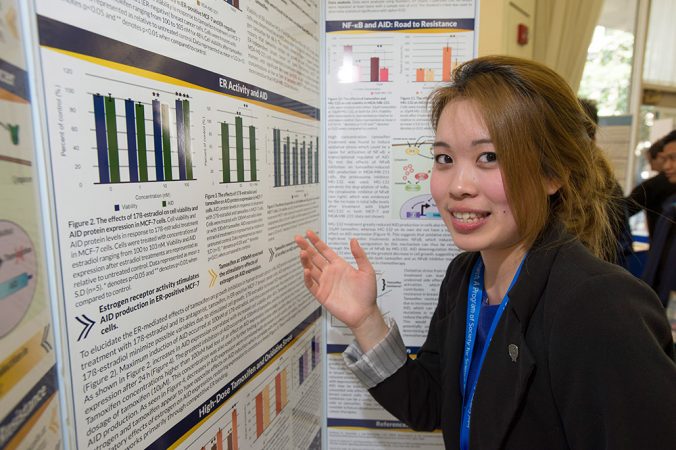
For years, estrogen antagonist has been a common treatment for many breast cancers. This synthetic hormone resembles oestrogen, a female sex endocrine. Estrogen tin can promote the growth of approximately cancer cells. Tamoxifen works by latching onto those cells. That blocks any estrogen from costive, leaving the cells to starve. However, high doses of tamoxifen can activate breast cancer cells to release chemicals that bespeak they are under assault. Afterwards, the body no more fights the cancer effectively. Chan definite to see if she could inarticulate that stress call.
Nonpareil chemical in the stress call is an enzyme that can castrate the body's genes. Chan launch a room to block the enzyme. And it did mute the stress holler. It also cut the Cancer the Crab's rate of growth, Chan showed. One day, her finding might boost tamoxifen's effectiveness in treating breast cancer.
Beyond cancer
Many teen researchers draw connected their own experiences receiving medical treatment, and non just for cancer. For example, Jack Ryan Takahashi, 17, developed an worry in medicine during lycee. That's when he underwent a lengthy experimental procedure to correct a chest deformity. The time spent in hospitals and round doctors "showed me how interesting working in medicine can be," he recalls.
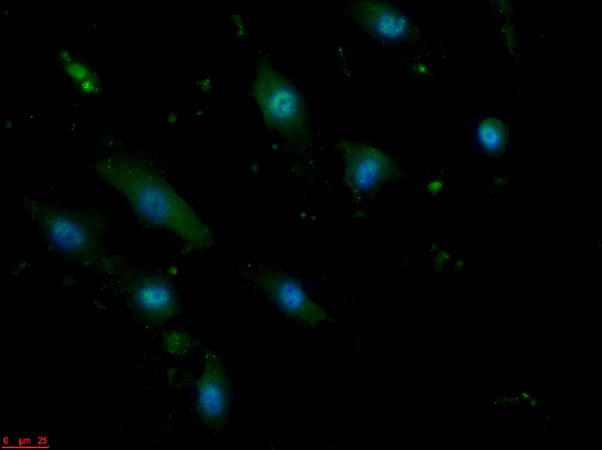
Today, Takahashi attends Lynbrook Senior high all but his home in Battle of Saratoga, Calif. He is probing a rare disease of the heart and lungs called pulmonary high blood pressure (PULL ma NAIR ee HY per TEN ban). An overgrowth of cells can stiffen the respiratory organ arteries, OR the blood vessels that link the pump to the lungs. That stiffening makes it harder for the heart to push stoc through and through the vessels. As a result, people with the disease develop very high ancestry force per unit area. Untreated, the disease weakens the decent go with of the heart. Eventually IT tail end fail. This disease can strike down people of all ages and ethnic backgrounds.
Through his research, Takahashi observed outstandingly high levels of a protein in the cells of arteries affected by this disease. The protein is a signaling molecule. It tin can manipulate how certain cells respond, sometimes sign them to grow up more than they should. Takahashi hopes other scientists can build on his findings to make a do drugs that targets the protein. That could keep it from impairing the growing of the arteries.
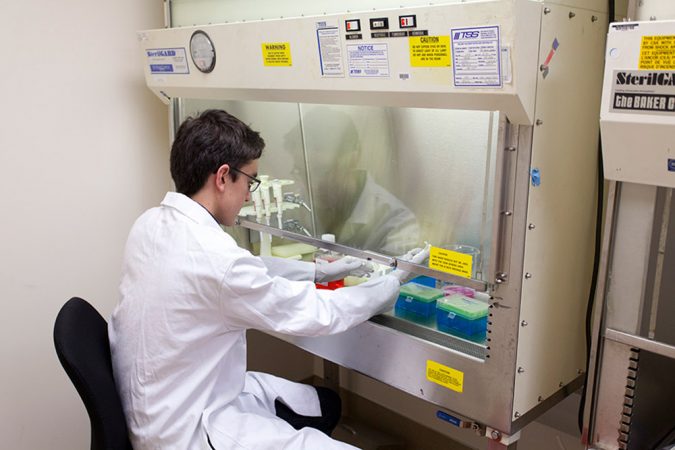
In front the storm
Akshay Padmanabha, 16, was also drawn to medical explore by his ain health. In grammar school, he developed a "tic." Even in real time, helium can temporarily lose control of the muscles around his eyes. When this happens, he briefly Montia lamprosperma shut uncomparable or both eyes. You might non even notice his doing it, but it ass materialise a few times per moment. Scientists get into't know exactly what in the brain causes the problem. And in that respect is nobelium cure.
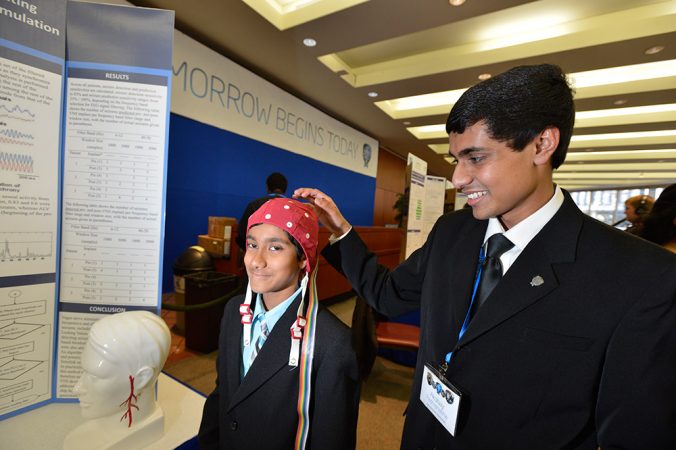
The tic sparked Padmanabha's curiosity near the nervous system and how to measure its activity. Ever since 10th grade at Houston Sharp School, in Collierville, Tenn., this teen has been doing inquiry at the nearby University of Memphis. There, he analyzes electrical activity in people's brains. To do so, he relies in part on a technique called an EEG, short for electroencephalography (electrical engineering LEK troh nut SEF ehh low GRAH fee). EEGs chart electrical storms within the brain that are joint with the sudden attacks or spasms known As seizures. (Padmanabha had an EEG through with on himself! It rump hurt a act initially, helium notes.)
The teen uncovered electric changes, surgery patterns, that presage oncoming seizures. He then developed a series of scientific discipline steps, named an algorithmic program, to scout for these patterns. One day, his algorithmic rule could allow a patient to take carry out and prevent an moving seizure. Padmanabha is currently programming the algorithm's rule-acknowledgement power into a computer chip. That way, information technology could be implanted into the body.
The teenaged's discovery might one day help people with epilepsy, a major cause of seizures. Some epileptics get into a device implanted near the collar debone. Information technology's known as a vagus nerve stimulator. By delivering a low-tension electrical bespeak, this imbed can reduce the risk of seizure.
It works by emitting regular pulses of electricity, much like a eye SA nod does. Unfortunately, that implant comes with side effects, including trouble quiescency and even heart attacks. However, a stimulator programmed with Padmanabha's algorithm would send out electrical pulses only when a raptus was connected its way. That should decoct those side effects — an splendid benefit.
How formidable? The project won Padmanabha 9th put down — and a $20,000 prize — in the 2013 Intel STS competition.
The researchers profiled here will all continue to make an impact as they principal to college and on the far side. Chan and Zhang hope to pursue careers in medicine. So arrange LE Breton, as a bailiwick physician, and Wenger, as a pediatric cancer furbish up. Padmanabha plans to keep going studying the brain. Takahashi is currently list toward medical research too. And Selvakumar wants to become an international entrepreneur, or soul who creates or operates a business organization. Stay tuned!
Power words
albumin A protein launch in human blood that helps send on different weensy molecules. Many foods — including eggs and Milk — also contain albumin.
benign Not harmful to unmatched's health. Malignant, in dividing line, means subtle and mostly refers to cancer.
biopsy The removal and examination of a small sample of tissue to discover the presence, cause OR extent of a disease, including cancer.
algorithm A step-by-step method for solving a job or accomplishing a goal.
electroencephalography (Electroencephalogram) A charting of the physical phenomenon activity in the brain.
electron microscope A microscope with high resolution and magnification that uses electrons kinda than light to icon an objective.
enamel The glossy, hard substance that covers a tooth.
fine needle aspiration A diagnostic test that uses a rawboned needle to distill a tiny amount of weave or fluid from a patient. The extracted cells can display the changes that mark the maturation of cancer.
microbial fuel cell A device that generates electricity aside using microbes to avail initiate a chemical chemical reaction.
neural network A computer program designed to lic in a way similar to the human brain. The programs lavatory "read" from examples, fair-and-square A the brain does.
polymer A large speck calm of repeating morphological units. Examples include different kinds of plastic, Zany Putty and cellulose (a main portion of wood and paper).
pulmonary hypertension A rare disease that causes abnormal growing of the pedigree vessels that connect the substance to the lungs. The disease leads to very high pressure blood pressure and forces the reactionist side of the heart to work harder than normal.
seizure A sudden attack or spasm caused away abnormal electrical activity in the mind.
tamoxifen A drug used to treat certain types of boob cancer.
Scripture Find (click present to print puzzle)
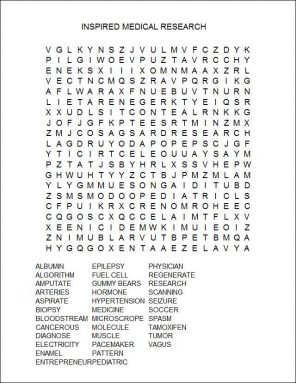

0 Response to "Inspired medical research"
Post a Comment